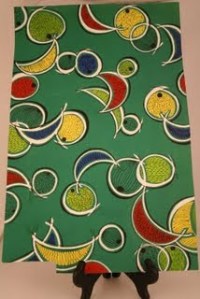 An Introduction to the Collection
An Introduction to the Collection
With over 2,000 textile samples from the 1950s, this collection provides a truly unique perspective into the East German textile industry, fashion and the development of consumerism within the GDR. The textile collection at the Wende Museum provides an opportunity to address both the Socialist and Western influences on fashion and textile production in Eastern Socialist countries.
These textiles come mainly from two locations: the Hungarotex Company’s manufacturing factory in Budapest, Hungary and the VEB (volkseigener Betrieb) Zentrales musterbüro für Druck (the central design bureau for printing) in Greiz, Germany. Based on the German, English and French labels on the textile samples from the Hungarotex Textile factory, the East German textile industry played a role (to some extent) in global trade.
Brief Overview of the Textile Industry
Throughout the 1950s, the East German textile and garment industry remained ineffective at meeting both the quality and quantity demands from domestic consumers and international trade-partners alike. Levels upon levels of state neglect and ineffective policies led much of the textile factory’s products to be either at levels of excessive surplus or in great demand.
In the early 1950s, this surplus was frequently forced into nearby socialist markets (such as the Soviet Union), saturating their markets with cheap and poorly produced fabrics and designs. As time passed, other Eastern European nations (namely Hungary) began producing higher quality textiles at a lower cost, forcing the East German government to reevaluate its production methods.
The textile and garment industry in East Germany at its most basic level was divided into three specific types of factories: privately owned, government owned and half government owned. However, despite its basic divisions, the textile industry suffered from complicated bureaucratic protocol and unsuccessful production policies.
In the early 1950s, textile factories produced a surplus of cheaply made fabrics that consequently over-saturated domestic markets and other socialist country’s markets. By the late 1950s, the GDR’s textile exports fell drastically as other socialist countries (most notably Hungary) began producing higher quality textiles. Increased competition and production during this period raises the question of who was setting the standard: did socialist governments mandate the designs of textiles for trade abroad, or did the international market dictate how socialist countries designed textiles.
The Textile Industry: Production and Trade
Due to the heavy toll from World War II, many industries (including the textile industry) remained heavily populated by female workers.The samples in this collection “indicate… a direct and close collaboration with ‘capitalist’ countries”. First and foremost, the Hungarotex brand (a Hungarian textile company) was traded internationally and maintained accountants and fashion shows in various countries including England, Belgium, Germany, Syria, Lebanon, Kuwait and more. Although Hungarotex did maintain international markets, its presence in East Europe further fueled the competition amongst fellow socialist countries.
Fashion and Design
Fashion and design became a paradox in East German society. While many women fervently read magazines such as Frau von Heute (Women of Today) and Die Neue Mode (New Fashion), almost all of the “fancy” clothing featured was inaccessible to the average East German woman. In addition, because of limited incomes and limited available sizes, many consumers were forced to make their own main article of clothing (such as a dress or skirt) from paper designs.
In political terms, fashion became both the state’s greatest asset and liability. By providing paper designs and supporting individual’s designs the government claimed its population was self-sufficient and successful. Yet, the reality of the situation was that the government rarely provided the needed amounts of high quality fabric and clothing for the general public.
During the 1950s, the textile and fashion industry in Eastern European socialist countries were heavily influenced by Western fashion styles. This new Western influence coincided with the elimination of East Germany wartime rationing in 1953, compelling consumers and fashion-lovers alike to demand a higher supply and quality clothing. Rising levels of consumption of fabrics, textiles and general fashion compelled the East Germany government to alter its production standards in order to compete with the international market and to meet consumer both domestic and foreign demand. However, as East Germany increased its production quality and textile design to compete with East European markets, Hungarian textile producers started to look abroad for new demand. In order to compete in the global market, Hungarian textile companies began to focus on creating popular Western fashion designs rather than East European designs.
 Consumerism and Women
Consumerism and Women
With the conclusion of World War II, many citizens shifted away from wartime thriftiness and the “aus alt mach neu” (“make new from old”) slogan that Nazi leaders had endorsed. Instead, East Germans (specifically women) flocked to various stores in search of, not just clothing but specific items of clothing. In fact, due to the unreliability and, at times, poor quality of many types of clothing, many shoppers fell victim to “impulse shopping”.


What great prints on the textiles!Also, Dederon is an interesting 'national' fiber, symbolizing triumph of science and chemistry, etc. It was promoted, but I wonder how GDR's fashionistas actually perceived it?
Bonjour,
J’ai acheté dernièrement le fond d’un atelier de design en tissu (plusieurs miliers de dessins à la gouache et une partie des archives) : ARTEL à Paris, atelier de Jacques Duthoit. J’ai retrouvé la trace d’achat de nombreux dessins de tissu par Hungarotex (acheteurs/ May, Tokech ou Tokes) dans les années 1960. Auriez-vous trace de ces achats de dessins? J’essaie de reconstituer le devenir des dessins de cet atelier qui a vendu dans le monde entier des années 1950 à 1970.
Je vous serais très reconnaissant si vous pouviez prendre ma question en considération.
Bien cordialement,
Pierre Epifanie
Bordeaux (France)